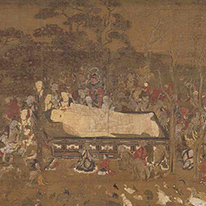Past Exhibitions
- Parinirvana: Death of the Buddha Paintings
- January 17, 2017 - February 19, 2017
The historical Buddha Shakyamuni is said to have died and entered nirvana on the fifteenth day of the second month by the lunar calendar. By the Gregorian calendar, this translates to March 15, which is when Japanese temples today hold the Parinirvana Ritual (nehan-e). The image hung for this ceremony is typically a painting of the Death of the Buddha.
Many Death of the Buddha paintings are oversized; some are so large that they cannot be fully unrolled, even in grand temple halls. Scholars have long puzzled over the reason for such massive dimensions. In recent years, some have speculated that enormous Death of the Buddha paintings gave the viewers a more immersive experience—providing a sort of virtual reality. During the Kamakura period (1185–1333), artists were increasingly incorporating new Chinese artistic styles into their Death of the Buddha paintings. These included realistic modes of expression that were more engaging for viewers. The Parinirvana Ritual probably became a staple of Japanese Buddhism because of the grand scale and realism of its Death of the Buddha paintings and because of its focus on the historical Buddha Shakyamuni, who is worshiped by many different Buddhist sects.












